If your kids love the water as much as mine do, a kayak is a great addition to your outdoor adventure gear. Not only are kayaks easy for kids to use, but they’re also a great way to get outside and explore! Whether you’re kayaking on a lake, pond, river, bay, or open ocean, kayaking is always an adventure! Today, we’re sharing tips for parents to help get their kids on the water safely, how to get started kayaking with kids, and our recommendation for the best kayaks for kids! Let’s get paddling!
*Post contains affiliate links. This post was sponsored by Evrwild, maker of premium kids’ kayaks. Kayaks in the photos were provided for review purposes. All opinions expressed and photos herein belong to the author.

Kayaking with kids
If kayaking with your kids is something you’d like to try, we’re here to help! Getting your kids interested in kayaking is probably easier than you think. Kids love being on the water, and kayaking is a really fun way to explore your local waterways. Start talking to your kids about your paddling adventures, the wildlife and nature they’ll see on their trip, and how you can’t wait to spend this time with them. You can also encourage them by letting them try sitting in a kayak at home or at a sporting goods store, or enroll them in a kayaking class if they’re old enough.
Once they’re interested, start planning your kayaking trip together so that your child feels involved at every step of the journey. Suggest some of their favorite local lakes, ponds, or bay to get started. Or, choose a familiar route that you know will be interesting for them and keep their attention. Or consider letting them invite a friend if you have a second adult available to help supervise. The main thing is that they have fun, so make that the purpose of your trip.
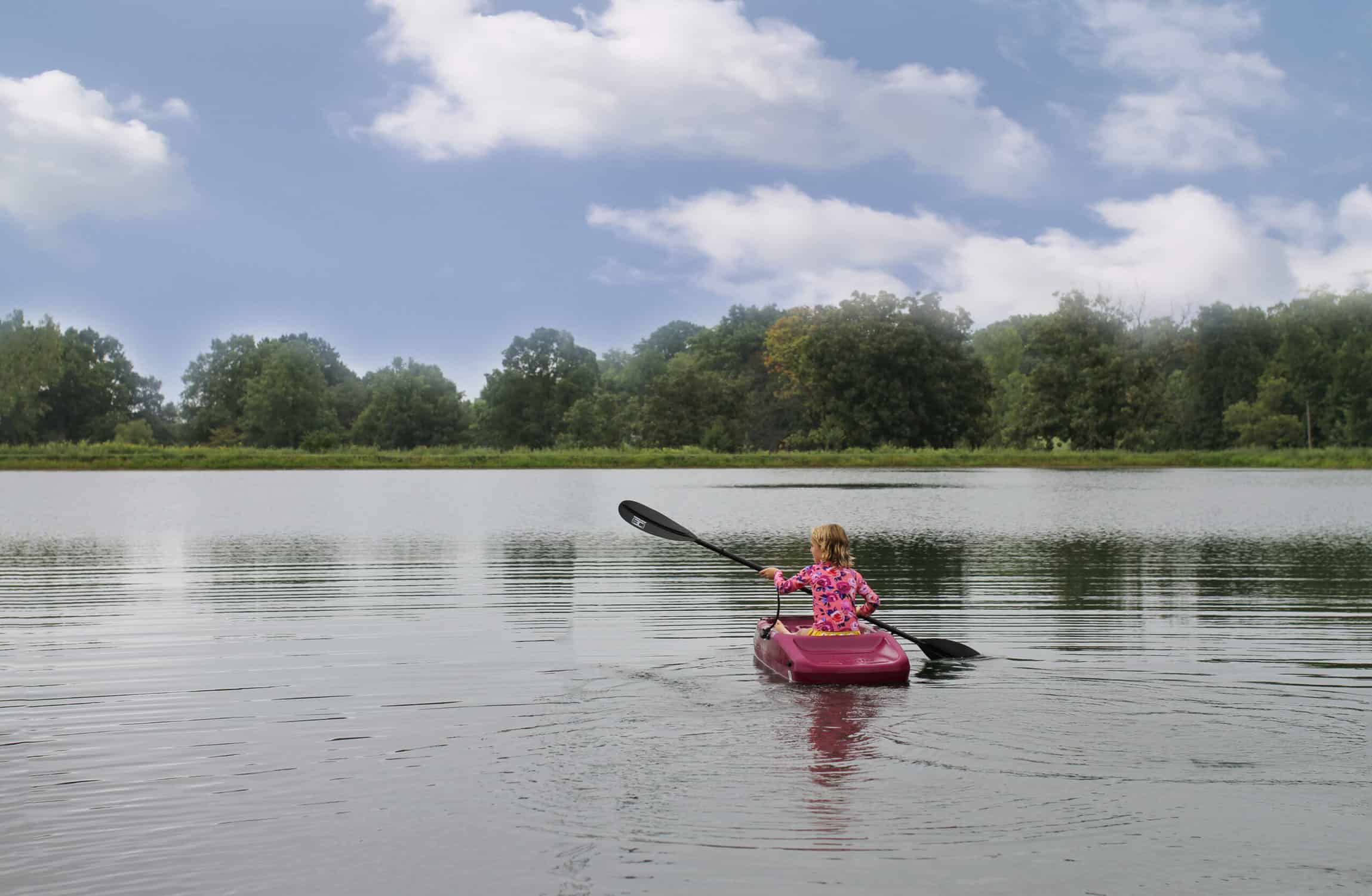
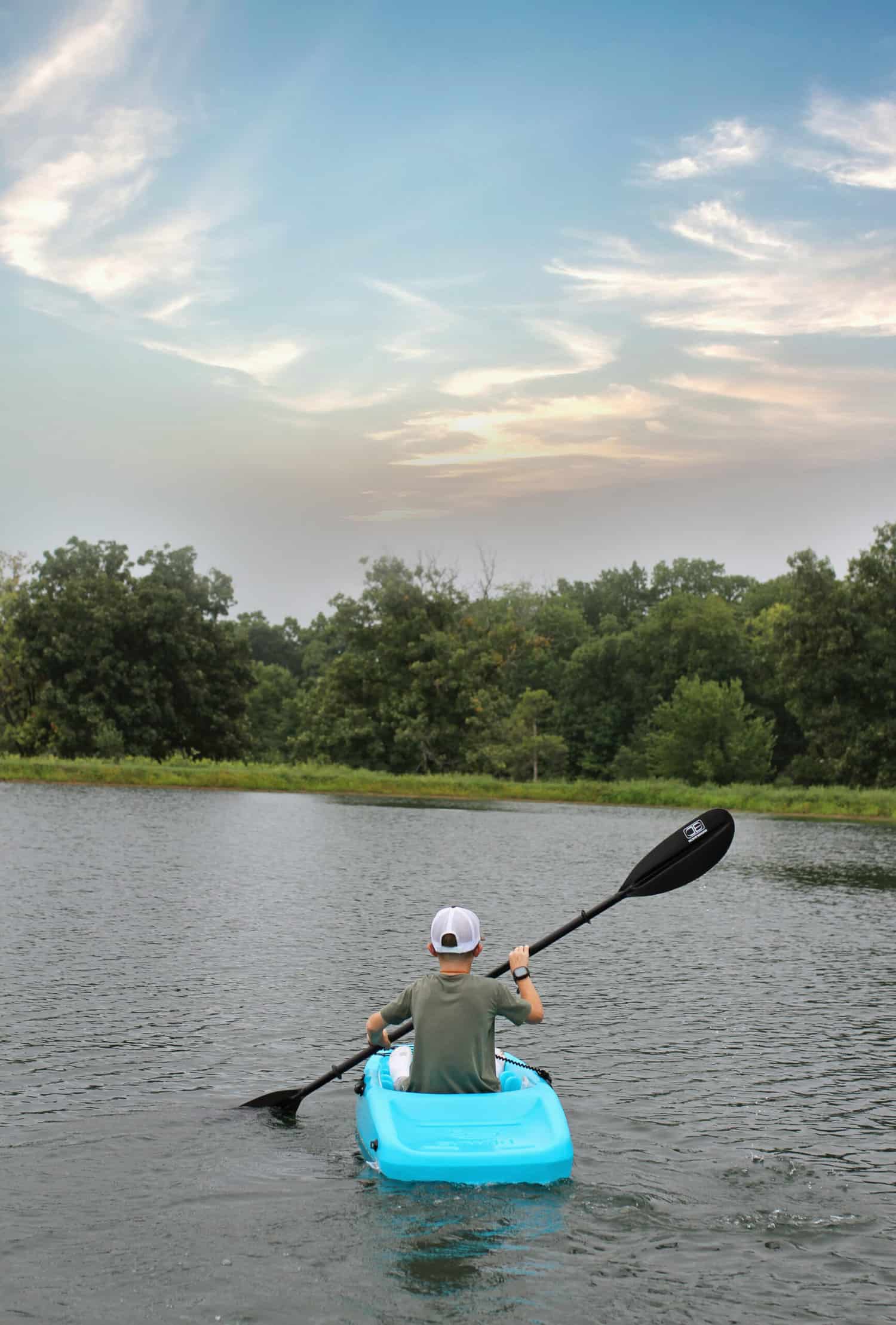
Benefits of kayaking for kids
Kayaking is a highly popular water-based activity, but it also provides kids with a host of different benefits. Here are a few benefits of kayaking for kids that we really appreciate:
-
Nature appreciation – Kayaking can be a superb way to help foster a love and appreciation for nature and the world around them. From a kayak, your child will be able to see things in and on the water that they’d never see from land. This can awaken their sense of curiosity about ecology, wildlife, and the environment.
-
Unique vantage point – There’s nothing better than seeing birds and animals from a close vantage point, and kayaking can be a great way to achieve this. It can allow your kid to explore areas that they wouldn’t be able to reach on foot, which gives them a whole new perspective on and appreciation of the world around them.
-
Teaches cooperation and determination – In order to successfully complete a kayak trip, everyone needs to work together. This will help your child learn how important it is for everyone to cooperate in order to achieve a common goal. Kayaking can be a challenging activity, especially for beginners. It takes time, effort and practice to master the art and learn a new skill. This can be an excellent lesson for kids, that with hard work and dedication, they can achieve anything they set their mind to.
- Water safety – When kayaking, kids learn to act responsibly while on the water in order to protect themselves and others around them. They must be good listeners and follow the rules. They learn to appreciate water and weather conditions, evaluate their skill levels, and be safe around water.
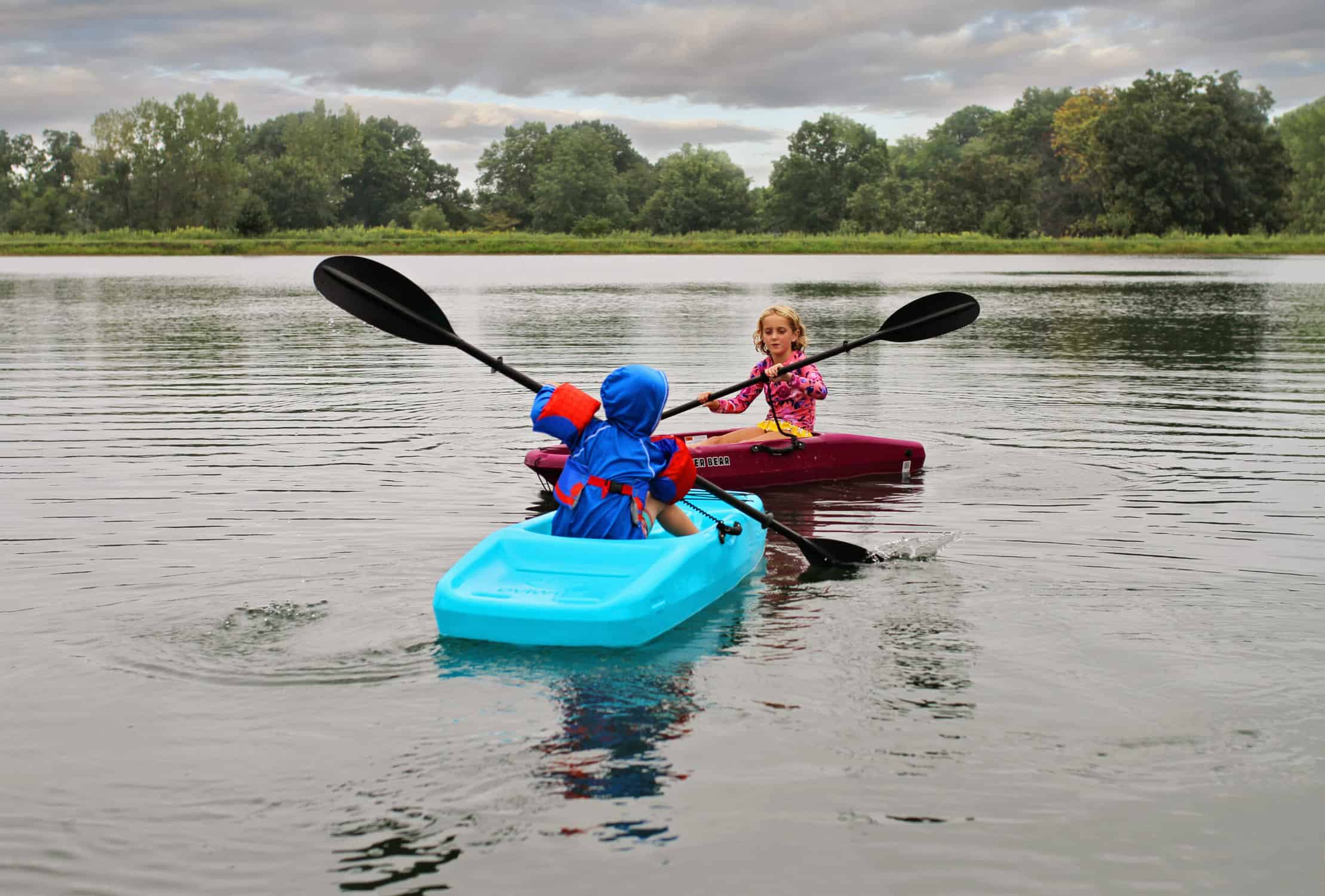
Best age to start kayaking with kids
Kayaking is one of our family’s favorite water sports. And one of the great things about kayaking is that you can start kayaking with kids from an early age. The age at which you start kayaking with your kids will depend on the child’s maturity level, swimming skills, and physical ability, as well as your own kayaking skill and experience.
Kids as young as 2 or 3 can kayak with a grown-up by sitting in the center of a tandem kayak (called “duffing”). However, this is only recommended if you have some kayaking experience, your child can sit still for the length of your kayaking adventure and can float on their own face-up when wearing a personal-floatation device. This is a great option for smaller kids and toddlers to get them started.
Around age 5, kids can sit in the front seat of a double kayak and help paddle. This is also the age when younger children can consider getting a solo kayak that’s the right size for them.

When can a child paddle their own kayak?
Kids can start practicing their kayaking skills in a single child-sized kayak on calm water as young as four years old. At this age, practice will primarily involve holding the paddle, practicing moving it around, and paddling for a few minutes. In calm waters, young children can manage very short distances in a small kayak. There should always be a skilled adult close by, and small children should wear a PFD and be able to swim.
By the age of seven, most kids will be able to paddle their own kid-sized kayak independently. By this age, most kids have a longer attention span and the physical strength needed to kayak continuously for half a mile to a mile (this means younger paddlers should be able to paddle between a half an hour to an hour).
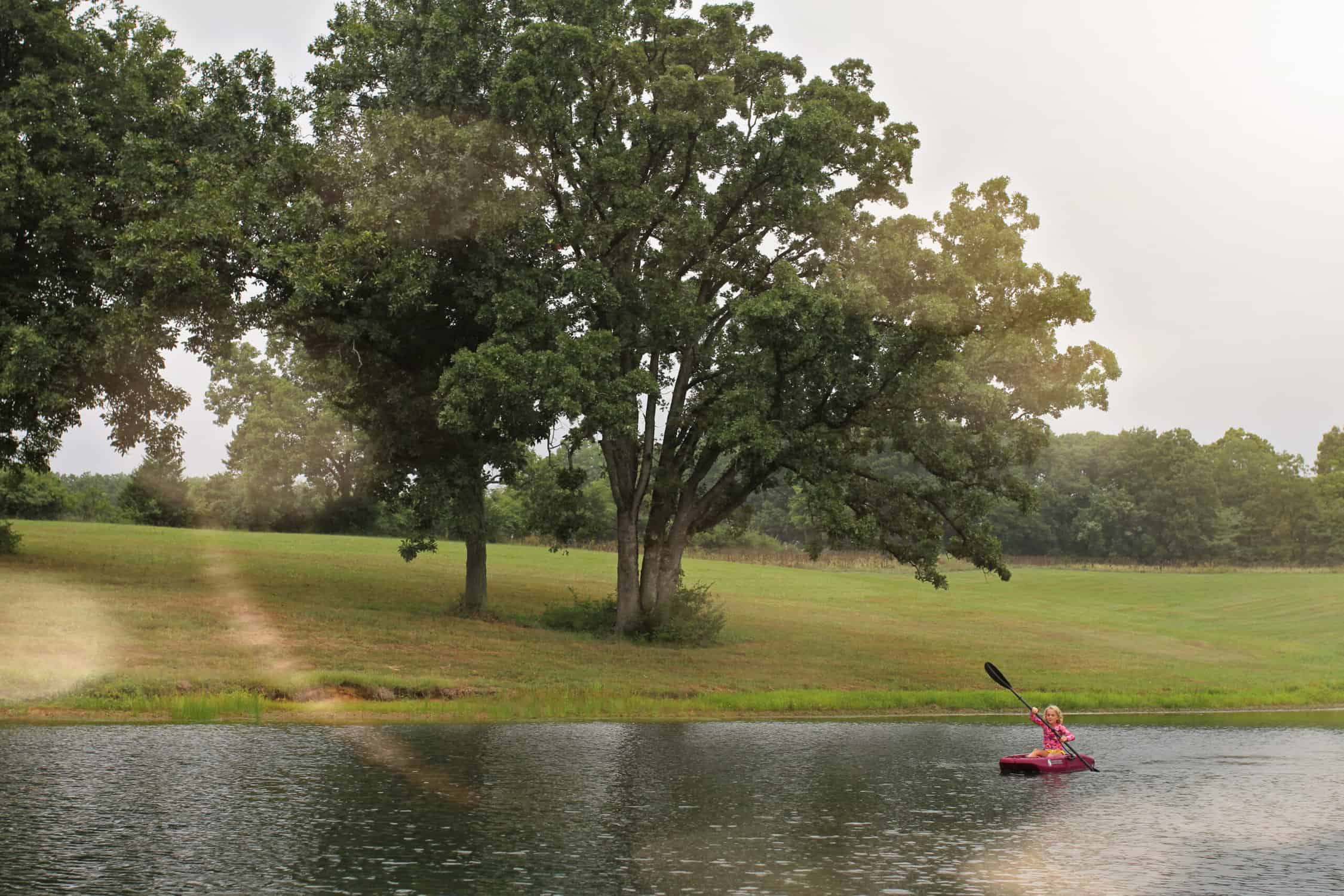
Safety tips for kayaking with kids
1. Personal floatation devices
All children under 13 years of age are required to wear a U.S. Coast Guard-approved wearable life vest or personal flotation device (PFD) when on a boat. There are different size requirements for children of different weights. Infant-size PFDs fit children who are 8-30 lbs. and have a neck pad and a crotch strap. Child-size PFDs fit kids 30-50 lbs. Youth PFDs fit kids that are 50-90 lbs.
2. Choose the right location to kayak
Another important safety consideration when kayaking with kids is choosing your destination. Locations with high currents, waves, or heavy boat traffic can easily become scary and overwhelming for kids. When starting kayaking with young kids, we highly recommend starting in calm open waters that are clear, no waves or wind, and are less trafficked by larger boats. The first time your kids kayak should be a safe and fun (and relatively short) outing.
3. Master a few skills
It’s highly recommended that your kids know how to swim before you start kayaking with kids. Even with a personal floatation device, knowing how to get in and out of your kayak and what to do in case of tipping over or getting stuck is important. Before you go, make sure to practice wet-exits, braces, and other safety techniques. REI has some great posts on these topics: How to Do a Wet Exit from a Kayak (for sit-in kayaks) and How to Edge and Do a Brace Stroke in Your Kayak. The best way to be prepared is to practice.
4. Smaller paddle
The paddle is your connection with the water, so be sure to get your child a paddle that is the right size and comfortable. Kayak paddles come in various sizes for children. You’ll want one that is shorter and lighter than adult-sized kayaking paddles. The perfect paddle length for your child will depend on their height and the kayak’s width. But usually, child-specific paddles will be shorter, lighter, and with smaller blades than regular paddles. Consider paddles that are about 200 cm long with a narrow shaft. Kids can tire easily and will have more trouble managing a large paddle that’s large and unruly for them. The right paddle could make the difference between a pleasant trip and a frustrating (and exhausting) one.
5. Know before you go
Water and weather conditions are important when deciding where to kayak with kids. Make sure you do your research on the place where you’ll be kayaking with kids. Study tides, currents, and boat traffic with the kids ahead of time so you know what to expect (and when). Be sure to check the weather forecast ahead of your trip so that you know what to expect (and then check again on the day of your kayaking excursion).
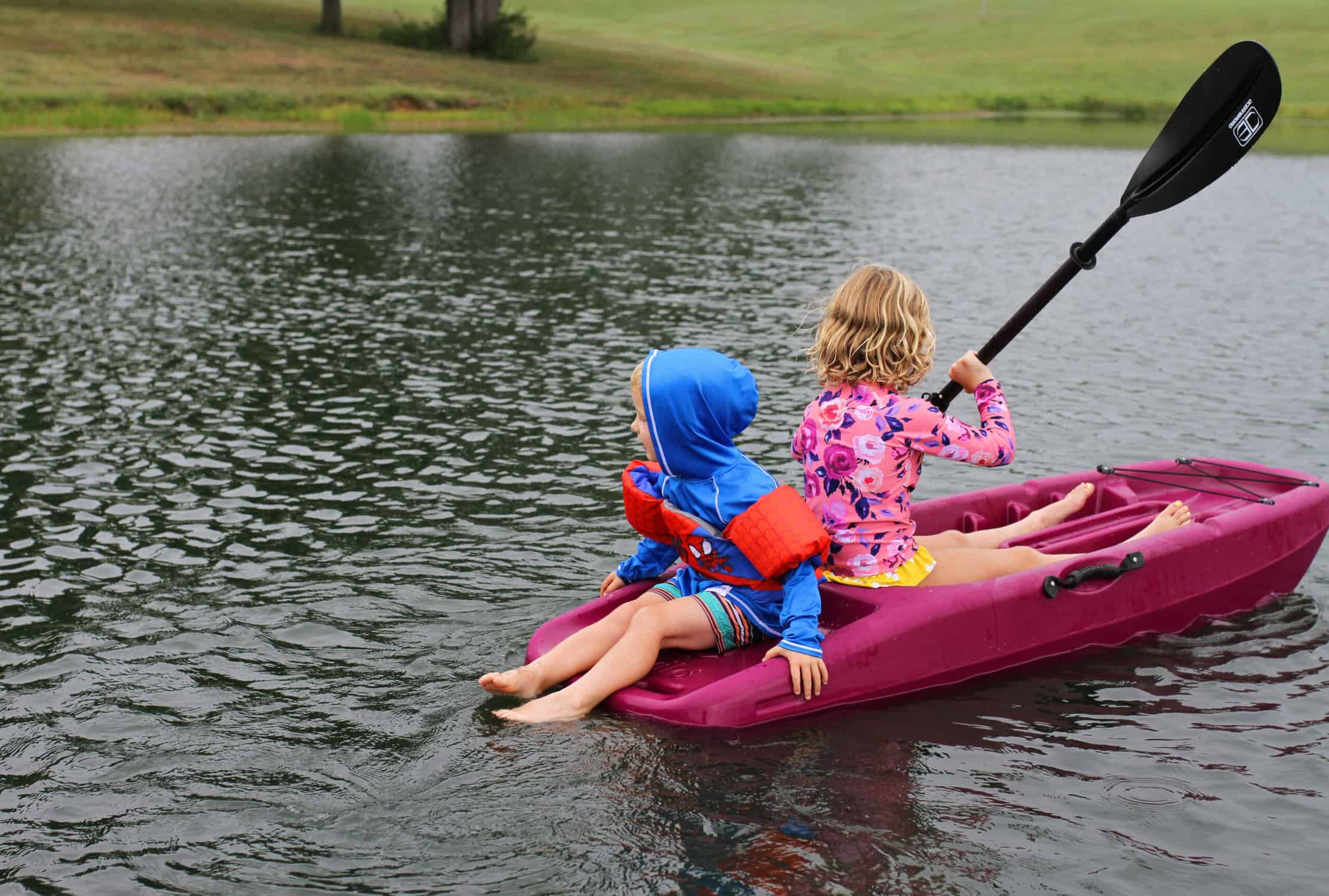
6. Never strap a child into a kayak
Never ever strap your child into a kayak. Although you may think this is a good idea for wiggly children, it’s extremely dangerous if you capsize.
7. Set the rules
Safety rules are essential when spending time on the water with kids. Before you ever get into the water, let your kids know the rules and what the consequences will be if they do not follow them. Kayaking rules may be different when on a small pond, as opposed to going down a river with current. Make sure your child knows how far from you they can go and any rules about stopping along the way. Depending on your kayaking location, other rules could include the following:
- Life jackets are to be worn at all times.
- No standing on the kayaks.
- No fooling around, leaning, or reaching out of the kayak.
- No jumping in and out of the kayak without permission.
- Paddles are not toys and should only be used for paddling, not as a play pretend sword or fighting staff.

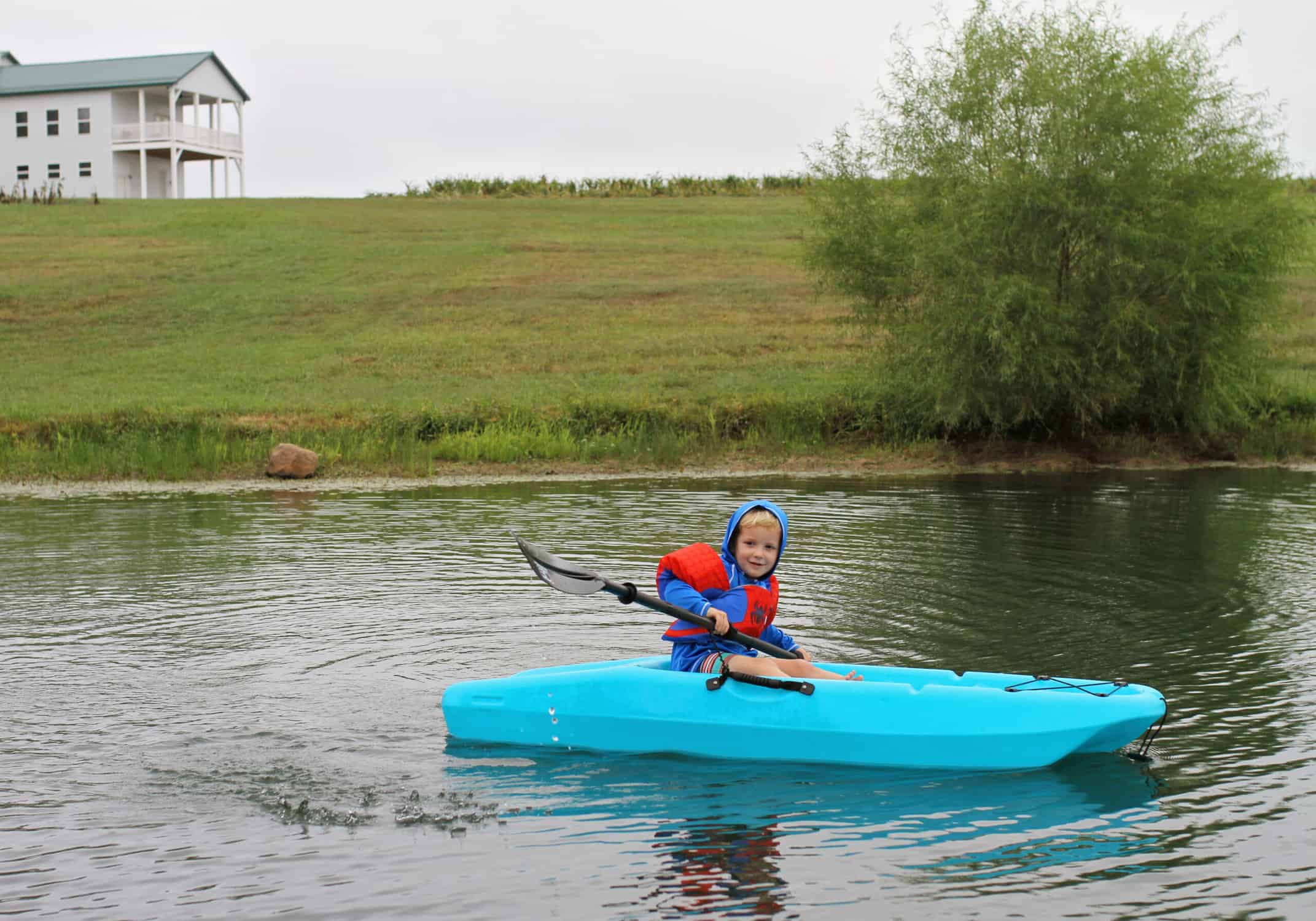
8. Have a plan
Create a float plan each time you go paddling, and inform a friend or family member where you’re going and when to expect you back. Go over emergency situations with the other adults (and older children) so that you know who’s in charge of what if a situation should arise. Your plan should include what to do if a boat tips over (capsizes), someone gets hurt, falls out of their boat, or gets separated from the fleet. Procedures should be established and understood by each adult for each of these situations.
8. Maintain your ratio
You should always aim to have one adult for every child in your kayaking group until you’re confident in all paddlers’ skills and experience, including kids. Beginner paddlers should never take kids on the water without an experienced kayaker to accompany them.
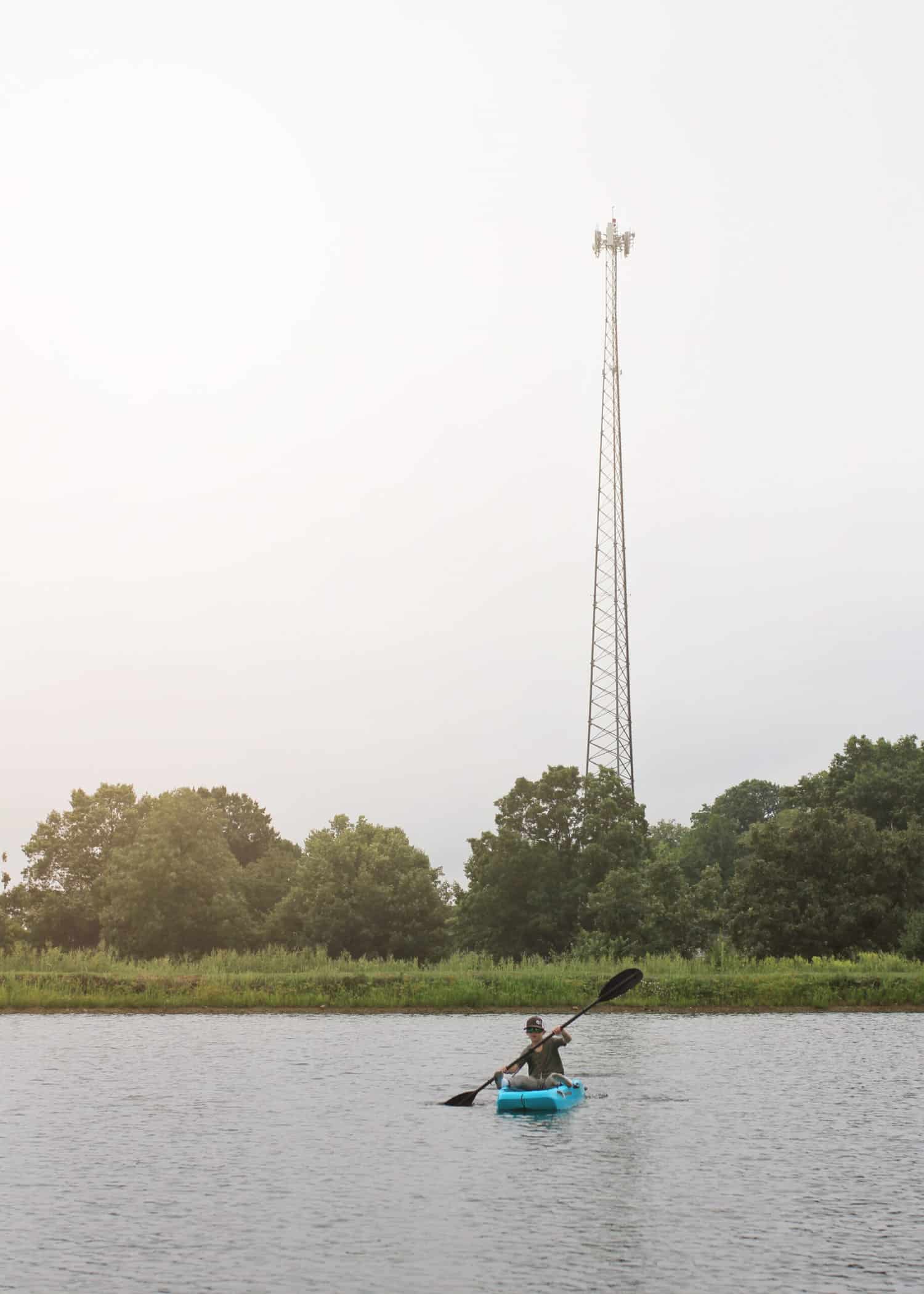
Best places to kayak with kids
Unless you are a very experienced kayaker, you will generally want to find calm water and minimal current to start kayaking with kids. The best places to go kayaking with kids have little to no current and lots of things to do and see.
Small protected lakes, bays, and slow rivers or streams are a great place to start kayaking with kids in order to develop your child’s paddling and navigation skills. Places with different landscapes, wildlife, bridges, tunnels, and other features are fun and motivating for kids to kayak through. Shallow waters also make kayaking stress free and fun. One-way downstream paddling is fun for kids at this age because it requires little strength (not a lot of paddling) and is a lot of fun.
To find kid-friendly paddling destinations, talk to experienced paddlers or paddling experts at your local outdoor shop. You might also try your county or state parks service websites or a local conservation agent. Local parenting Facebook groups or outdoor adventure clubs are also great resources and can provide lots of options for safe kayaking locations.
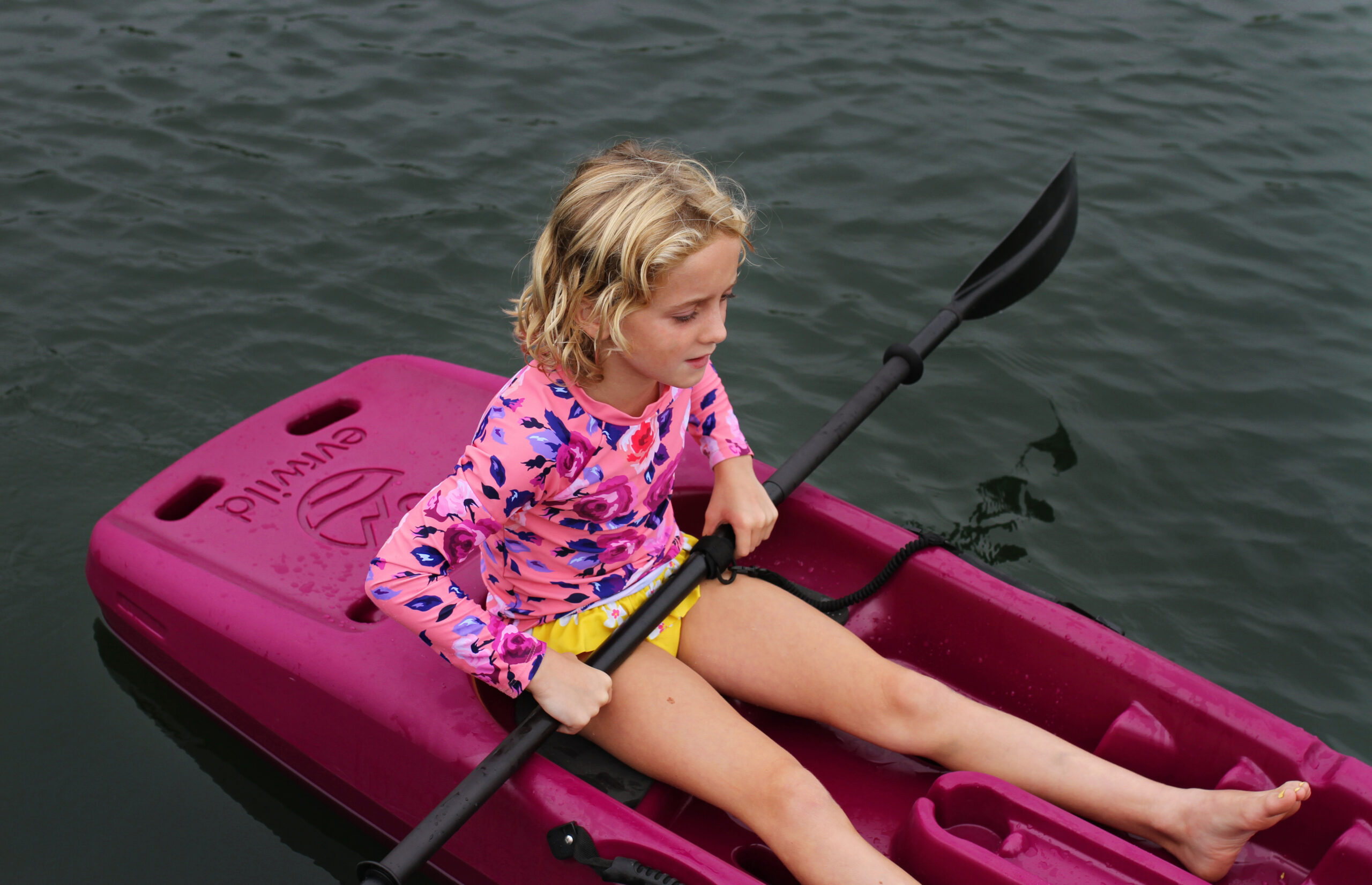
What to bring when kayaking with kids
- Paddles
- PFDs
- Reef-safe sunscreen
- Hat/sunglasses
- Dry bag for phone, camera, snacks, etc.
- Sandals/water shoes
- Water bottles
- Float bag
- Tow/throw rope
- First aid kit
- Quick dry clothing
- Towels
- Snacks
How to choose a kayak for kids
Once your child has mastered the basic paddle strokes and safety techniques and has the maturity to paddle solo, you might want to consider getting them a child-sized kayak of their own. Adult kayaks are built for adults and are not always the best option for kids (even larger kids). Kayaks designed specifically for kids will help your child learn to be a confident kayaker and last for years.
There are two main different types of kayaks – sit-on kayaks and sit-in kayaks. Sit-on-top kayaks are probably the easiest kayak to start with kids and the best choice for warm water kayaking. These types of kayaks offer a variety of positions for kids to sit in, which helps them get comfortable and stay in the kayak longer.
Sit-on kayaks (as opposed to a sit-in kayak) also tend to be more stable, difficult to capsize, and nearly impossible to sink because they have built-in drainage holes. Kids often prefer sit-on-top kayaks because they’re less restricting. They’re also easier to enter and exit, meaning that your kid can go for a swim and climb back on. And, if they flip over, the water drains out easily and quickly.
When choosing a kayak for kids, you’ll also want to consider the size and weight of the kayak. Buying a kayak is an investment, so you want one that’s easy to transport (so you’ll actually use it) and can be used for years as your child grows. Other things to consider (and great features to have) are storage options, ergonomic features, durability, carry handles, and material.

Best kayak for kids: Evrwild Kayak
Started by a mom and dad during the pandemic, Evrwild Kayaks are the best youth kayak and child-sized option for kids. The Evrwild Water Bear Youth Kayak is specifically designed for kids ages 4-12. And it’s not just a scaled-down version of an adult-sized kayak.
Evrwild kayaks are ergonomically designed with everything a child needs while out on the water. Footrests that fit a kid, a cup holder within easy reach, and places to store special finds and gear that kids love. On top of that, the Evrwild kayak is a sit-on-top kayak that’s built to the highest standards of quality and durability, ensuring many years of adventure.
The wide stance provides a stable paddling platform to keep your child safely in the kayak. The Evrwild kayak has a padded slip-resistant seat, swim-up deck (for easy re-entry), paddle rest, and stable hull design with great maneuverability and steady tracking.
We absolutely LOVE our Evrwild kayaks. They are easy enough for my 4-year-old to maneuver, but large and sturdy enough for the 10-year-old to use as a fishing kayak. The swim-up step comes in very handy when kids are in and out of the water.
The Evrwild kayaks come in two colors – blue and purple. It’s made in the USA and comes with a 5-year limited warranty. We think it’s the best kids kayak on the market.
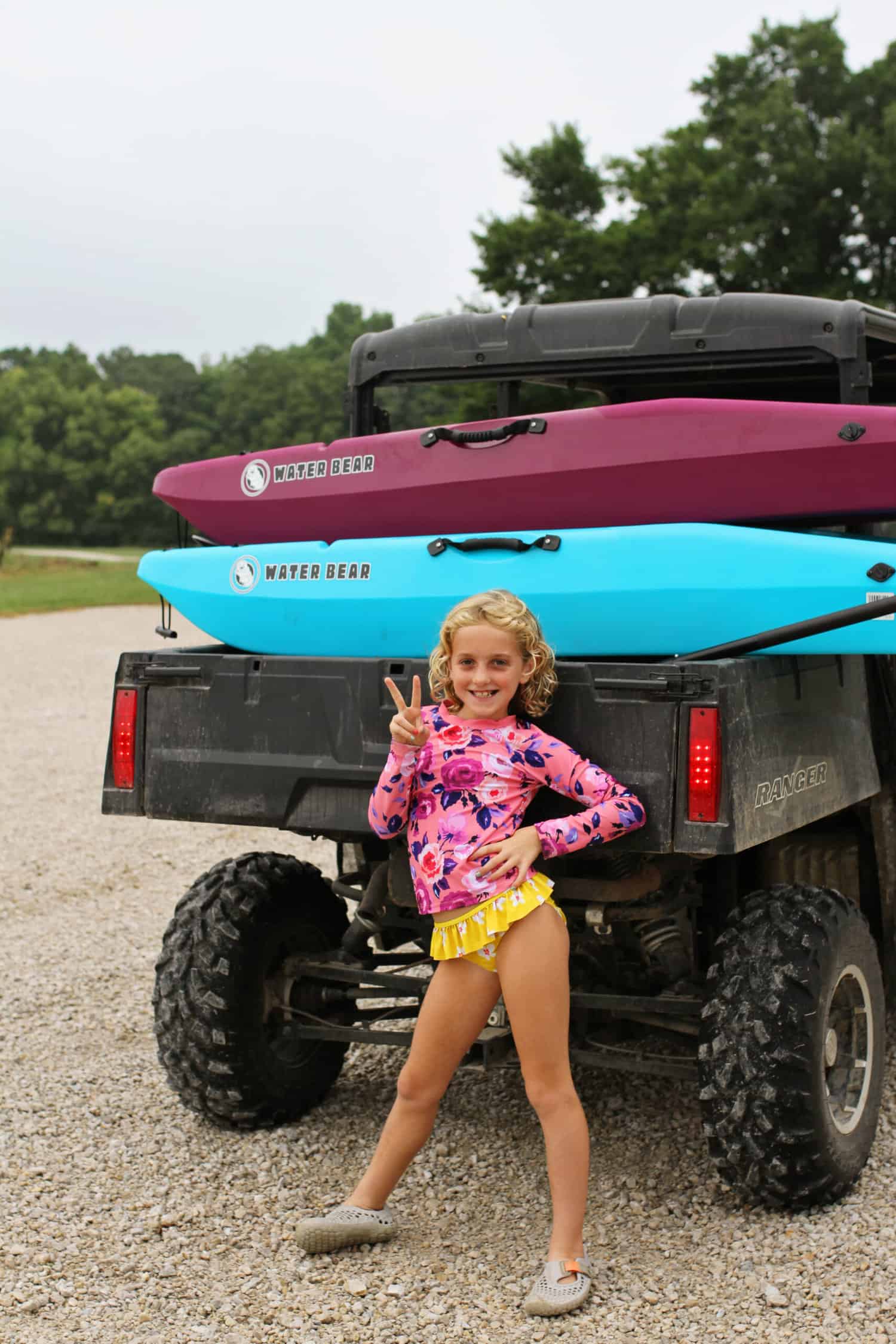
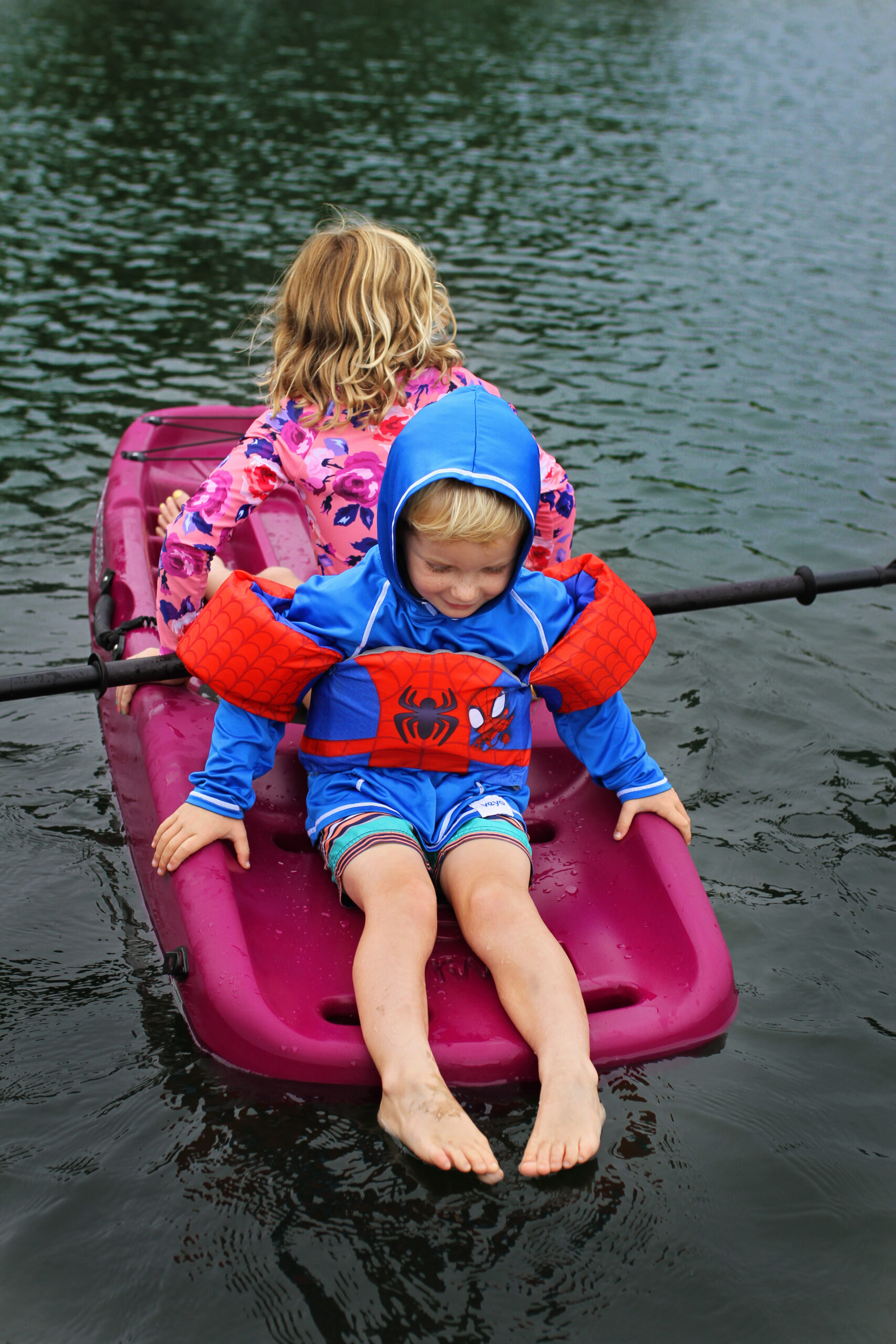












3 comments